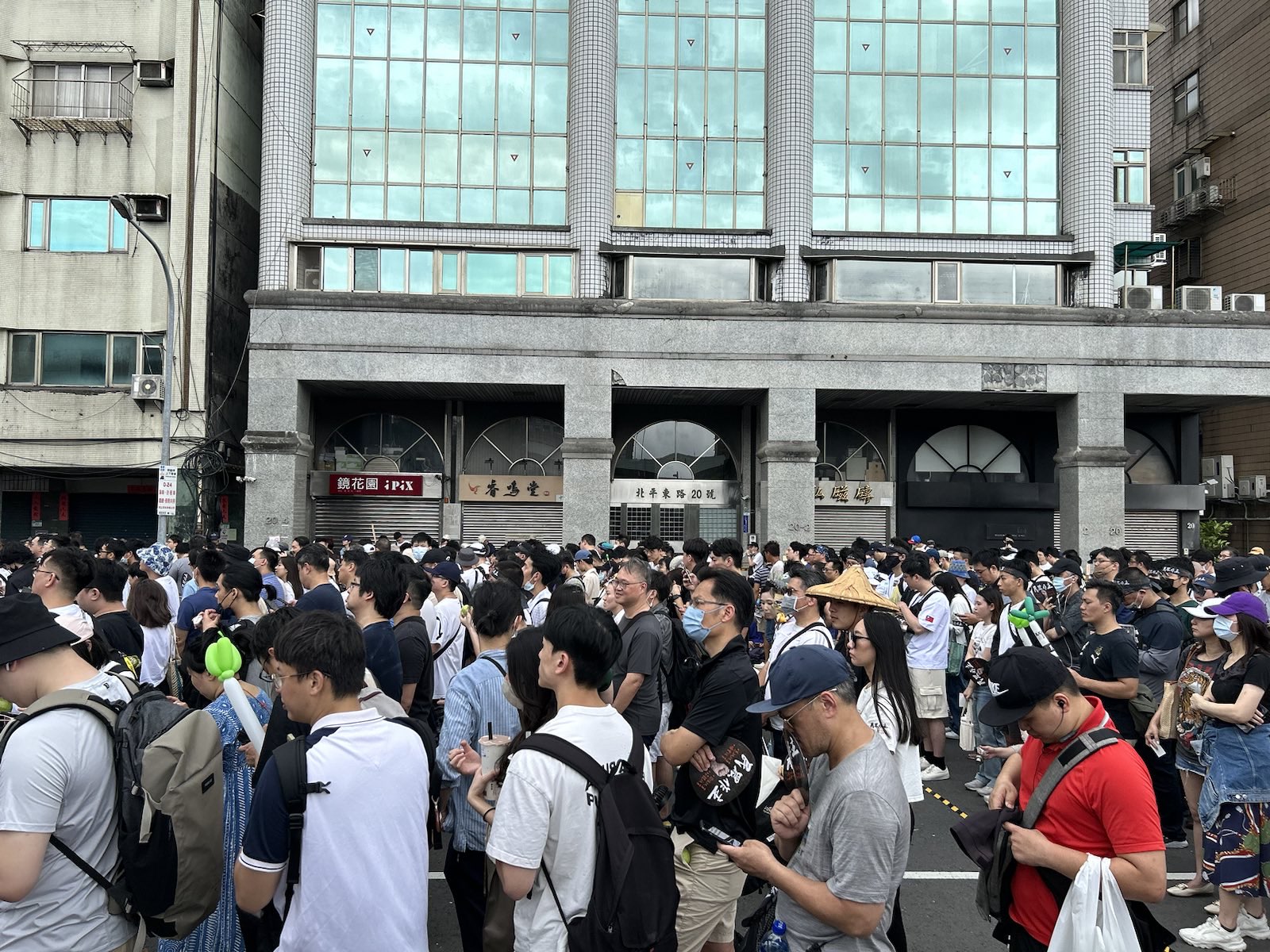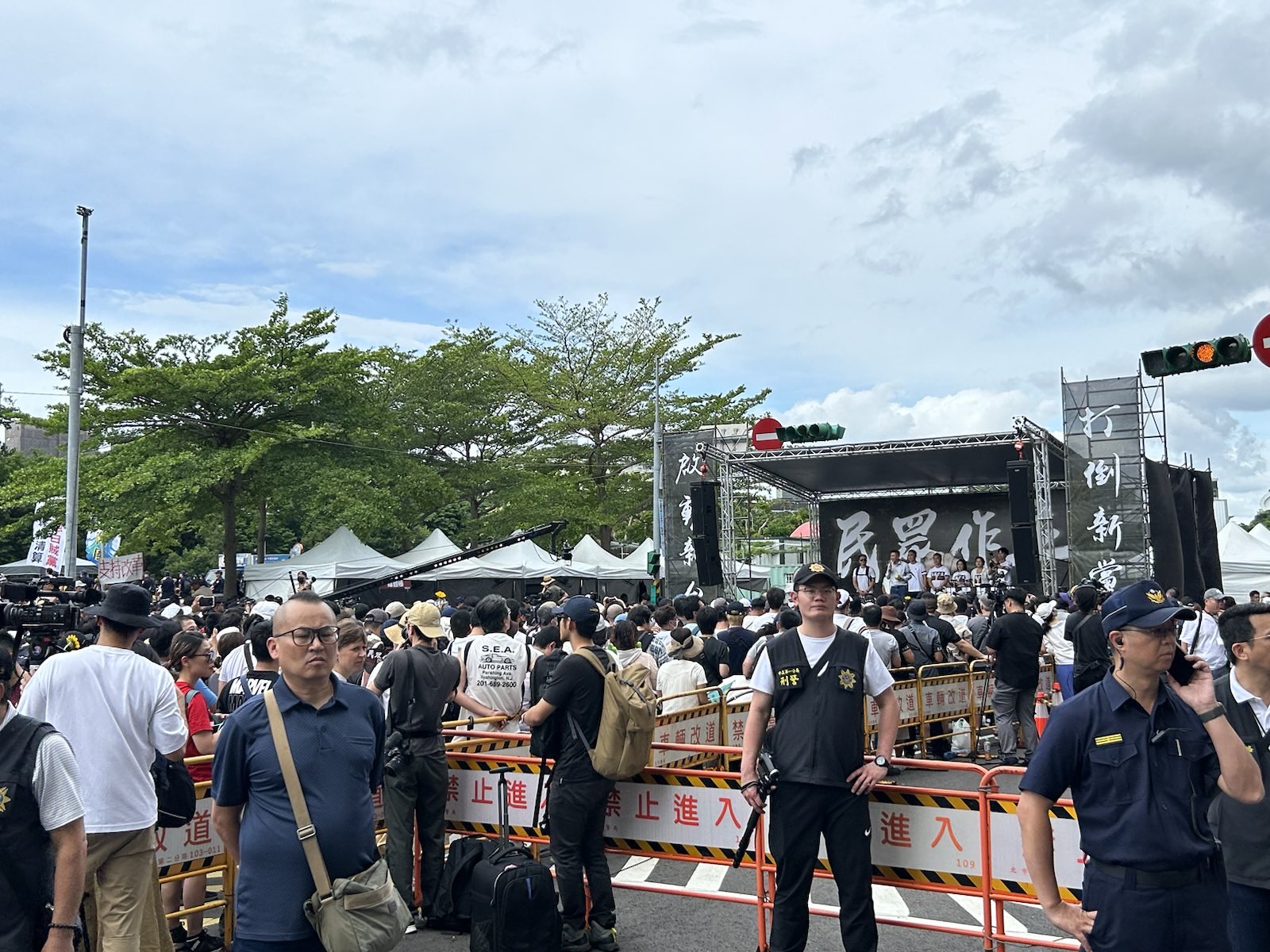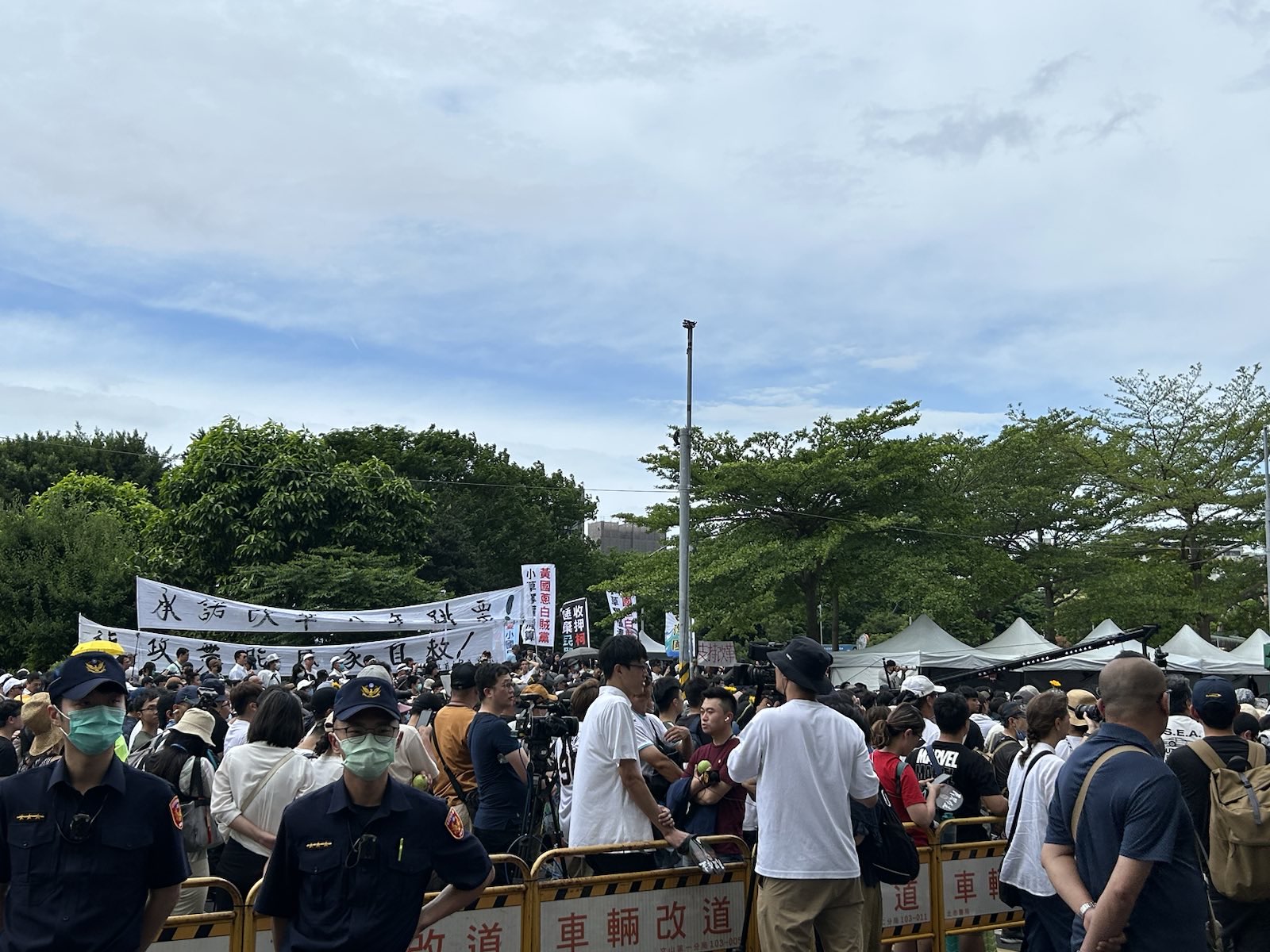by Brian Hioe
語言:
English
Photo Credit: Brian Hioe
THE TPP DEMONSTRATED in front of DPP headquarters near Shandao Temple today. The demonstration drew several thousand, with some estimates that around 5,000 attended.
In particular, the rally was timed for before Lai Ching-te’s presidential inauguration tomorrow, as well as in the wake of the violence that took place in the Legislative Yuan on Friday. The rally largely focused on criticizing the DPP.
 Photo credit: Brian Hioe
Photo credit: Brian Hioe
As the TPP supports the legal changes pushed for by the KMT, the DPP was framed as responsible for the violence in the legislature. This was although four DPP legislators were hospitalized, while only one KMT legislator was hospitalized after the fighting in the legislature. The legal changes would give legislators the power to summon government officials or private individuals for questioning and prosecute them for contempt of the legislature if they refuse, but critics fear that the pan-Blue camp would target individuals politically using such powers. Fears regarding this led spontaneous protests to break out outside of the legislature on Friday night, with hundreds gathering despite the late night hour.
Consequently, by way of a Taiwanese pun, the framing of the party was to criticize the DPP as stealing and tricking the “guava votes” of the people, with the DPP being a “guava party”. Demonstrators were called on to bring guavas. Likewise, in line with how supporters of Ko Wen-je have termed themselves “Little Grass,” many demonstrators carried green plant props, though fewer “Little Grass” wear grass hair ornaments as compared to in the past.
 Guavas being held up at the rally. Photo credit: Brian Hioe
Guavas being held up at the rally. Photo credit: Brian Hioe
Otherwise, participants wore white, the colors of the TPP. To this extent, with the entrance of Huang Kuo-chang, the former NPP chair and among the prominent Sunflower Movement leaders, into the TPP as its caucus convener, some wore black and held up sunflowers in the demonstration. As the spontaneous protest on Friday likewise positioned itself as carrying on the legacy of the Sunflower Movement, this reflects to what extent the historical legacy of the movement ten years ago is still being fought over, with a number of political actors claiming its legacy.
The main slogan of the protest was “The people should decide” (民眾作主) and participants sometimes shouted “Mygopen,” meaning “You can’t fool me again” in Taiwanese Hokkien, to criticize what were claimed to be the DPP’s false promises.
 Individuals alleging that Tsai’s dissertation is fake at the protest. Photo credit Brian Hioe
Individuals alleging that Tsai’s dissertation is fake at the protest. Photo credit Brian Hioe
Certainly, Ko Wen-je originated as a candidate supported by Sunflower Movement activists when he made his political debut in running for Taipei mayor in 2014. But in the years since, he as well as Huang have pivoted towards the pan-Blue camp. As such, it proved ironic that the demonstration focused criticisms on Tsai Ing-wen of the DPP, who is often perceived as having been voted into the presidency on the basis of momentum after the Sunflower Movement. Likewise, it proved strange that the legacy of the Sunflower Movement–which broke out against concerns of the effects on Taiwan’s political freedoms from a trade deal with China that the KMT hoped to push for–was invoked for a political candidate as Ko, who has referred to both sides of the Taiwan Straits as being part of one family with a shared destiny.
 Photo credit: Brian Hioe
Photo credit: Brian Hioe
The protest generally focused on criticism of the Tsai administration. Tsai was criticized on a number of fronts. Some criticisms returned to the DPP’s failure to resolve issues of socioeconomic inequality facing young people, including low salaries, the declining birthrate, and unaffordable housing, as well as electricity shortages. Yet to this extent, the TPP’s framing was often that the DPP was implicated in corruption, suggesting that issues of fraud have become prevalent in Taiwanese society and that the DPP was linked to this.
 Photo credit: Brian Hioe
Photo credit: Brian Hioe
Many criticisms focused on the DPP’s COVID-19 response. While Taiwan went for more than a year without lockdowns and was able to relatively quickly contain COVID-19 when clusters finally did develop in Taiwan, the pan-Blue camp has focused fire on what it claims to be DPP corruption with regards to its programs to ramp up the production of medical masks and develop the domestically-manufactured vaccine, Medigen, at a time that Taiwan lacked vaccines. Sometimes Taiwan was depicted by the KMT as having one of the world’s worst COVID-19 responses as part of such efforts to politically attack the DPP. The TPP echoed such criticisms today. Indeed, there was very much an undertone of suggesting that Tsai should face legal charges for alleged corruption once out of office.
Among the TPP party heavyweights present were Ko and Huang, seemingly the leading individuals in the party at present in spite of Huang having only recently joined the TPP. Former Taipei deputy mayor Vivian Huang was also present, as well bodybuilder and streamer Holger Chen.
 Counter-protestors against the rally. Photo credit: Brian Hioe
Counter-protestors against the rally. Photo credit: Brian Hioe
The participants in the rally were mostly young people, but an odd mixture of pan-Blue groups were present. This included a group calling for a “cross-strait peace referendum”, advocacy with pro-unification leanings, as well as a group alleging that Tsai Ing-wen’s dissertation is fake, a conspiracy theory embraced by the pan-Blue camp and deep Greens critical of Tsai. Several banners hung up during the rally evidenced ROC nationalism. As with past TPP rallies, the composition of the rally slanted male, sometimes interpreted as due to the appeal of the machismo politics of Ko–known for his record of misogynistic statements–Holger Chen, or Huang Kuo-chang.
There were two groups of counter-protestors against the rally, one of older pro-independence groups who called on young people supporting Ko Wen-je to wake up. Another group was of young people themselves. Both positioned themselves at a distance from the TPP supporters, with police wading off the pro-independence groups, though some confrontations happened.
 Sunflower being held up the protest. Photo credit: Brian Hioe
Sunflower being held up the protest. Photo credit: Brian Hioe
Perhaps tellingly, among the loudest cheers during the rally were when Holger Chen criticized the DPP as a pro-independence party and claimed to that the ROC was part of his DNA. This may evidence the views of the young people in attendance, but as with the references to the Sunflower Movement, the ideology of the young people that back the TPP may be amorphous and somewhat inchoate, in line with the populist appeal heard during the rally to embody the people, or that statistics produced by the Tsai administration to show growth did not reflect true economic development.
 Grass and other vegetable imagery at the protest. Photo credit: Brian Hioe
Grass and other vegetable imagery at the protest. Photo credit: Brian Hioe
While the tendency in international media has sometimes been to interpret the TPP as the political party in Taiwan that has the support of young people, the spontaneous protest that broke out Friday night against the TPP and KMT’s actions in the legislature is reflective of how both pan-Blue and pan-Green views exist among young people. This is the case even if identity trends show that Taiwanese identity continues to be on the rise and Chinese identity on the decline, and even if the KMT has struggled in its efforts to appeal to youth in past years. It is telling, too, about the present weakness of the party that the KMT did not try and mobilize its supporters before the Lai inauguration in the same manner as Ko.
With the presidential inauguration set for tomorrow and the changes to legislative proceedings planned by the KMT set to resume discussion in the legislature on Tuesday, further protests from post-Sunflower Movement civil society groups are planned for Tuesday. But with the TPP’s mobilization today, this will further the sense of crisis regarding the pan-Blue camp’s efforts to grant legislature new powers it will likely use against opponents.

